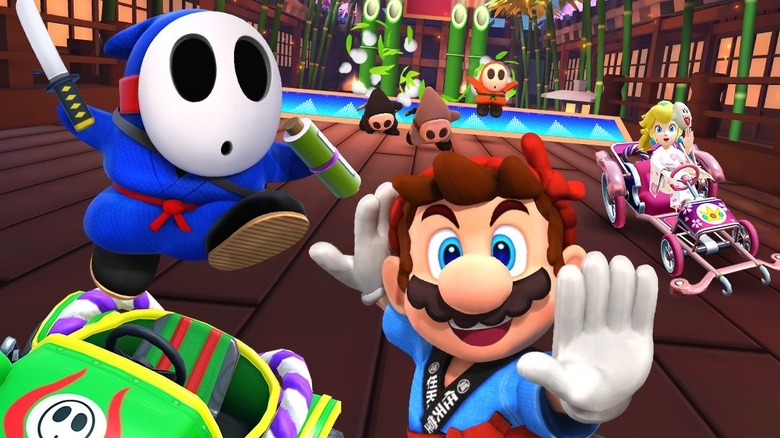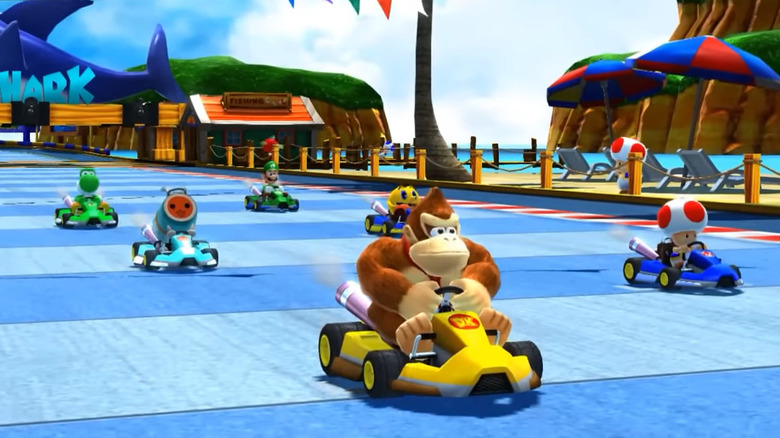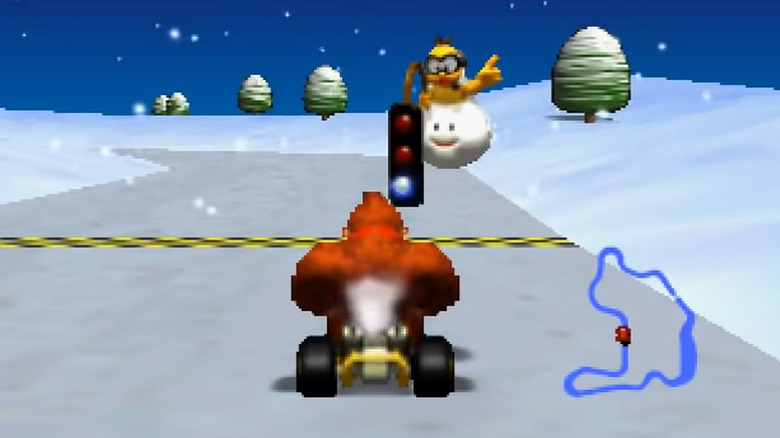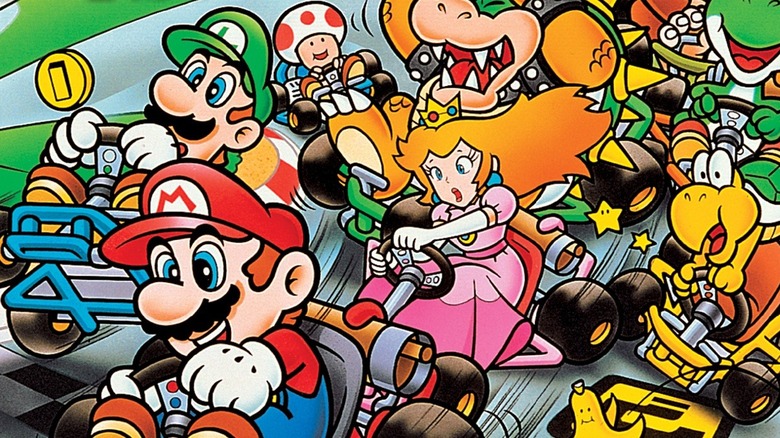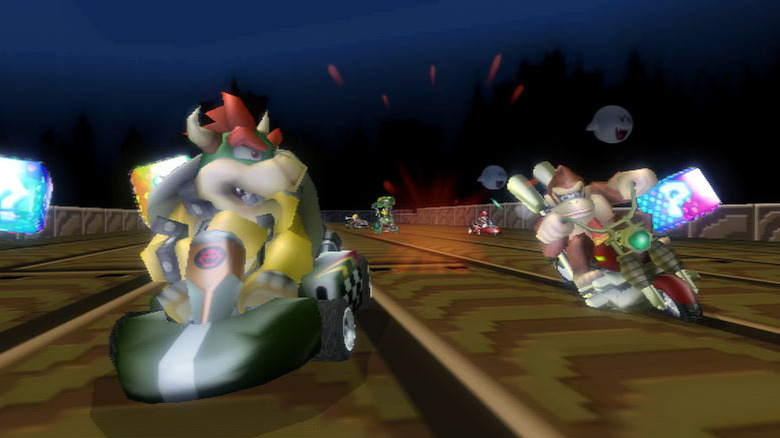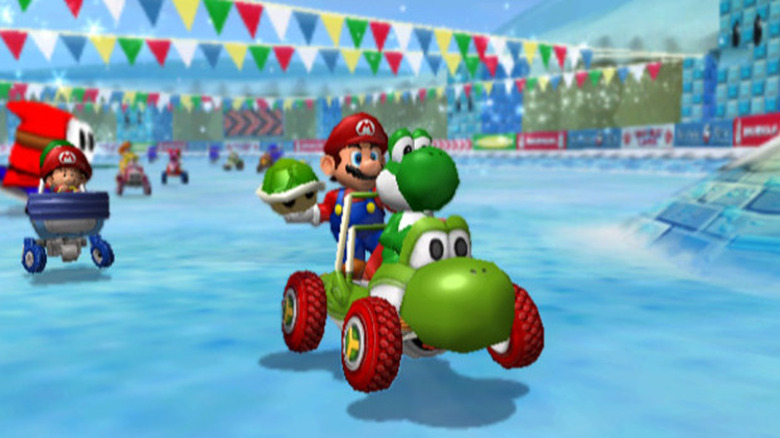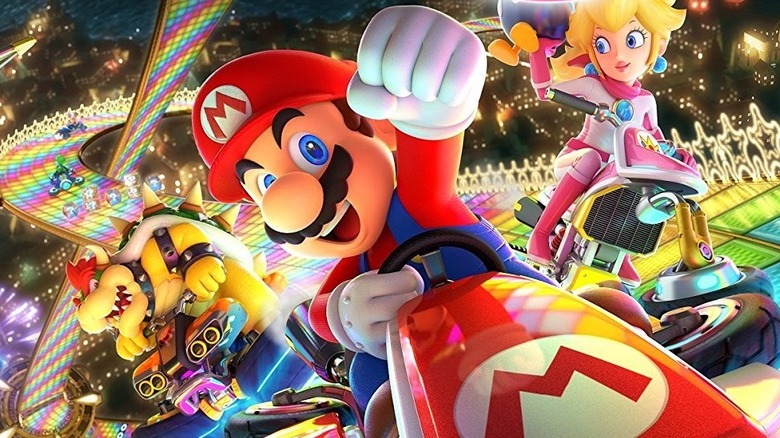Every Mario Kart Game Ranked Worst To Best
The original "Super Mario Kart" was released in 1992. For many millennials, that means growing up with "Mario Kart" titles on SNES, N64, and handheld devices, then having their own kids playing "Mario Kart" titles on the Nintendo Wii and Switch. No other video game racing franchise has stood the test of time like "Mario Kart," which has found ways to reinvent itself for each new generation of players.
But what makes "Mario Kart" stand out? Victory is always up for grabs, casual competition is embraced throughout the franchise, and it truly feels like it was built with everyone in mind. Kids can play with adults, inebriated adults can play with other inebriated adults, and so on. Whoever can best powerslide maneuver around the course while winning the war of items will usually take first place. However, "Mario Kart's" famous rubberbanding catch-up mechanics — like Blue Shells and Bullet Bills — mean that no "Mario Kart" race is a sure thing till the very end. As one Reddit user famously summarized playing "Mario Kart" in haiku, "I am in first place / Everyone is passing me / I am in last place."
"Mario Kart's" easy-to-understand and hard-to-master gameplay loop has made it a decades-spanning champion for Nintendo, but not all "Mario Kart" games are made the same. Each game has its particular quirks, so let's try to figure out which of those worked best!
14. Mario Kart Tour (Mobile, 2019)
Developed for mobile play on Android and Apple OS, "Mario Kart Tour" unfortunately comes in last place. Honestly, it is not because "Mario Kart Tour" is a bad game on its own merits. In fact, for a mobile game, it plays serviceably well. While it does have pernicious microtransactions that rightly upset critics, "Mario Kart Tour" only lives at the bottom of the "Mario Kart" ecosystem because the rest of the games in the franchise are so stellar.
To its credit, "Mario Kart Tour" borrows and modifies many gameplay elements from "Mario Kart 7" and "Mario Kart 8/Mario Kart 8 Deluxe," including character-specific items, aquatic driving, and flying glider sequences. However, it also offers some innovations of its own. Core mechanics like acceleration and boosting are automated so players can focus on steering and item usage. The most fun addition is Frenzy Mode, which allows players to spam the use of an item if they get three identical items from boxes.
There are some decent reasons why "Mario Kart Tour" became the most downloaded iOS game of 2019, but its microtransactions and comparisons to other games in the series slot it at the bottom of the totem pole.
- Release Date: September 25, 2019
- Genre: Racing Game
- Game Modes: Single-player, Multiplayer
- Metacritic Score: 59
13. Mario Kart Arcade GP VR (Arcade, 2017)
The latest installment in the "Mario Kart Arcade GP" series developed by Bandai Namco Games, "Mario Kart Arcade GP VR," takes players deeper into the "Mario Kart" universe like never before. Played with a virtual reality headset and controlled with physical steering wheels and brakes, the game also experiments with item usage by tracking wrist movements to determine how and when items are thrown.
Unfortunately, the game is only playable as one single-lap course. Even still, players have found that one lap to be exhilarating. Giant attacking Piranha Plants, towering Thwomps, and Bullet Bills racing across the sky all populate a high-octane "Mario Kart" arcade experience brought to virtual reality. Still, the lack of content for "Mario Kart Arcade GP VR" makes it hard to rank above other truly fleshed-out titles. Also, its physical requirements place restraints on accessibility for players. Overall, "Mario Kart Arcade GP VR" is a novel experience, albeit a limited one.
- Release Date: July 14, 2017 (in Japan)
- Genre: Racing Game
- Game Modes: Single-player, Multiplayer
- Metacritic Score: N/A
12. Mario Kart Arcade GP (Arcade, 2005)
"Mario Kart Arcade GP" is one of the least-known and least-played "Mario Kart" titles. Released across the world in 2005 as a first-person arcade gaming experience, translating "Mario Kart" into an arcade experience produced many interesting quirks. For example, the machines photographed players and gave them a customizable display avatar, emphasizing the in-person gaming experience. Furthermore, storage for player data on a magnetic card worked with different machines.
Changes to the gameplay of "Mario Kart" was also required. Lock-on for items makes the physical requirements of holding a steering wheel and pushing pedals less taxing. Temporary shielding for players when they powerslide also makes playing "Mario Kart Arcade VR" feel less punishing. Four-track cups are standard, but "Mario Kart Arcade GP," in line with arcade economics, requires players to insert more credits after every race. Most interestingly, "Mario Kart Arcade GP" has unique Challenge Games where players subvert standard racing mechanics in creative ways. Altogether, "Mario Kart's" gameplay mechanics pair well with a physical racing kart. It only ranks lowest in its sub-series due to its subsequent iteration's polish and additional content.
- Release Date: October 10, 2005 (in USA)
- Genre: Racing Game
- Game Modes: Single-player, Multiplayer
- Metacritic Score: N/A
11. Mario Kart GP 2 (Arcade, 2007)
"Mario Kart Arcade GP 2" is hardly a standalone title from its predecessor, "Mario Kart Arcade GP." Instead, this second edition is akin to a DLC pack and a small balance patch.
The most important addition to "Mario Kart Arcade GP 2" is allowing players to customize karts, similar to what players enjoyed in "Mario Kart Double Dash!!" and "Mario Kart DS." Following in the footsteps of "Mario Kart Arcade GP," it has some of the only cross-franchise playable characters in a "Mario Kart" game with Pac-Man and a Tamagotchi character named Mametchi.
"Mario Kart Arcade GP 2" also adds a fun color commentator. An over-enthusiastic voice narrates every single move on the track, including little interactions between NPCs. Depending on the player's taste, this results in either a hilarious or infuriating time. Despite being basically just a rehash of the first game with four new tracks, the commentator earns "Mario Kart Arcade GP 2" one spot higher in this ranking.
- Release Date: March 14, 2007 (in Japan)
- Genre: Racing Game
- Game Modes: Single-player, Multiplayer
- Metacritic Score: N/A
10. Mario Kart GP DX (Arcade, 2013)
"Mario Kart Arcade GP DX" takes all the best parts from its two predecessors and refines them into a fantastic arcade experience. The core gameplay, items, driving roster, and graphical presentation of the "Mario Kart GP" series are brought to a successful crescendo with this installment.
The game's "Deluxe" moniker (DX) comes from its 30 courses, 20 characters, 120 karts, and 150+ items, which blow its predecessors out of the water. An upgrade to driving mechanics was also introduced with powerslide boost charging. Team Battles place players in 2-seater tanks and charge them with trying to take each other out, recalling the joy of "Mario Kart Double Dash!!"
Only one unique character, Don-chan from "Taiko no Tatsujin," was initially added to the roster. However, over time, "Mario Kart Arcade GP DX" has released content updates to introduce beloved characters like Baby Mario, Baby Peach, Daisy, King Boo, and Lakitu. These content updates provide "Mario Kart Arcade GP DX" cabinets longevity within arcades that have already invested in them. This is crucial, because they cost around $13,500 in direct-to-consumer pricing, and limited accessibility is one of the game's most significant problems.
Overall, "Mario Kart Arcade GP DX" shines brightest out of its cabinet contemporaries and deserves a play at local arcades.
- Release Date: July 25, 2015 (in Japan)
- Genre: Racing Game
- Game Modes: Single-player, Multiplayer
- Metacritic Score: N/A
9. Mario Kart Live: Home Circuit (Switch, 2020)
Ever wondered if "Mario Kart" needed infinitely modifiable tracks in mixed reality? Well, not many people could have predicted this peculiar addition to the "Mario Kart" roster. Its innovative mixed-reality set-up uses physical karts and a system of manually placed checkpoints to generate a track. That real-life track is then driven by camera-laden karts, which stream gamified footage back to the Nintendo Switch. This blending of Augmented Reality and physical products is exceptionally unique in the "Mario Kart" franchise, making this installment stand out among its peers.
The bundling of the "Mario Kart Live: Home Circuit" experience — $99 for two karts, four checkpoints, and two direction arrows — suggests that this product is intended for family households who love "Mario Kart." Unfortunately, the heightened price point for a game without a ton of content, on top of the spatial requirements to play, also means that "Mario Kart Live: Home Circuit" is only reaching the most dedicated and well-off of fans.
- Release Date: October 16, 2020
- Genre: Racing Game
- Game Modes: Single-player, Multiplayer
- Metacritic Score: 75
8. Mario Kart Super Circuit (GBA, 2001)
"Mario Kart Super Circuit" is the one and only "Mario Kart" game developed for the Game Boy Advance handheld system. In some ways, "Mario Kart Super Circuit" was a letdown after the highs of "Super Mario Kart" and "Mario Kart 64." Looking back, "Mario Super Circuit" doesn't have the same kind of nostalgia factor that playing the original two offer, and its graphics were scaled way back when compared to the 3D models of "Mario Kart 64." On top of those comparative drawbacks, while "Mario Kart Super Circuit" features a similar Battle Mode to "Mario Kart 64," it loses the verticality of the arenas due to hardware constraints.
It is not without its own merits, though. Most notably, "Mario Kart Super Circuit" offers a multiplayer system in which up to four players could join up via a Game Link Cable — and only one game cartridge is required to do so. Additionally, in retrospect, what was once considered a step down in graphical prowess now stands out as one of the best examples of colorful pixel art the Game Boy Advance ever produced. Overall, it is a solid game, even if it lacks the depth and quirks of other "Mario Kart" titles.
- Release Date: July 21, 2001
- Genre: Racing Game
- Game Modes: Single-player, Multiplayer
- Metacritic Score: 93
7. Mario Kart 64 (N64, 1996)
"Mario Kart 64" expanded on everything that worked in the original "Super Mario Kart." It gave the whole experience a facelift by using pre-rendered 2D sprites for characters and items and setting them on three-dimensional courses. Speaking of which, each course was a leap forward on its own, adding verticality and plenty of obstacles in the form of steep inclines, falling boulders, and more.
On top of the tracks and art style upgrades, "Mario Kart 64" refined several gameplay elements. One of the most significant areas for skill expression in "Mario Kart" games — how and when to use items — was drastically improved by this game's introduction of backwards item-holding and throwing.
At this point in the ranking, there are fewer negative points to dock for games on the level of "Mario Kart 64." Higher placements only come from slight pluses certain "Mario Kart" titles have over others. Consequentially, although "Mario Kart 64" is a phenomenal game, it lacks some of the competitive depth and inventive features of other "Mario Kart" hits. Also, it invented the dreaded Blue Shell, so it pays the price of being toward the bottom of the well-regarded "Mario Kart" games.
- Release Date: December 14, 1996
- Genre: Racing Game
- Game Modes: Single-player, Multiplayer
- Metacritic Score: 83
6. Mario Kart 7 (3DS, 2011)
Developed in tandem by Nintendo EAD and Retro Studios, "Mario Kart 7" successfully brought the beloved series to the Nintendo 3DS handheld system. Many of the core features that would become refined in "Mario Kart 8/Mario Kart 8 Deluxe" were made possible by the advancements in "Mario Kart 7." Most notably, the now-solidified features of underwater racing, hang-gliding aerial sequences, and stat-changing customizable karts made appearances in "Mario Kart 7." The addition of highly customizable karts brought about great new layers of competitive depth and made for more replayable tracks.
Another small feature that fans of the game appreciate is its incorporation of first-person driving, a rarity for "Mario Kart" games outside of the mixed reality and arcade titles. "Mario Kart 7" also deserves props for instituting online ghost data that allowed players to race against the best times of their friends via stored online data. The online-friendly development of "Mario Kart 7," paired with its longstanding additions to the core gameplay elements of "Mario Kart" games, keeps it near the upper echelon of the franchise.
- Release Date: December 1, 2011
- Genre: Racing Game
- Game Modes: Single-player, Multiplayer
- Metacritic Score: 85
5. Super Mario Kart (SNES, 1992)
Simplicity in games is often mistaken as a lack of depth, but "Super Mario Kart" proves that simple fun is what it takes to birth a decades-spanning franchise. No gaming franchise lasts as long as "Mario Kart" without its foundations being as solid as the Earth's crust. At its core, "Mario Kart" is an arcade-style battle racer with powersliding. That's it. As it turns out, that is all its original incarnation needed back in 1992.
Compared to the cliff-jumping and underwater cruising of contemporary "Mario Kart," the utterly flat terrain of "Super Mario Kart" tracks is jarringly simple. However, tightly powersliding around those easy-to-learn tracks against eager friends on the same TV produces so much enjoyment. The racing elements of "Super Mario Kart" are incredibly straightforward, possibly because its development team at Nintendo spent more time on the game's Battle Mode than the racing mode. Regardless of the intention behind it, Nintendo spawned a racing game behemoth with the runaway success of "Super Mario Kart."
- Release Date: August 27, 1992
- Genre: Racing Game
- Game Modes: Single-player, Multiplayer
- Metacritic Score: N/A
4. Mario Kart DS (DS, 2005)
"Mario Kart DS" is one of the most revered entries in the "Mario Kart" franchise due to its flawless online multiplayer implementation. For the first time in "Mario Kart" history, players across the world could play against each other on servers with minimal lag and connectivity issues, a staggering feat for online play in 2005 (especially on a handheld console). Local area multiplayer was also innovated with a special feature that allowed play with up to eight players through a single game cartridge. As a result, "Mario Kart DS" was a memory-making machine for young gamers of the DS generation.
Additionally, "Mario Kart DS" shines in its own light because of its unique Mission Mode challenges. More than 50+ of these condition-based races were invented as part of a single-player campaign structure. Also, series staple items like Bullet Bills and Blooper Squids first appeared here. On a different note, taking advantage of the already illustrious history of the "Mario Kart" franchise, "Mario Kart DS" was the first game in the series to feature revamped retro tracks. As such, "Mario Kart DS" takes the successes of its predecessors and translates them into a widely-played multiplayer phenomenon, earning it a top spot in the franchise's storied history.
- Release Date: November 14, 2005
- Genre: Racing Game
- Game Modes: Single-player, Multiplayer
- Metacritic Score: 91
3. 3. Mario Kart Wii (Wii, 2008)
Earning the bronze medal in this ranking, "Mario Kart Wii" is a tremendous success. In raw numbers, "Mario Kart Wii" is the 2nd best-selling game on the Nintendo Wii, and it is the 2nd best-selling "Mario Kart" game in the franchise's history with over 37+ million copies sold. It profited immensely from the household success of the Nintendo Wii by developing a motion-controlled plastic wheel to pair with the game.
The motion controls may have been a primary draw for "Mario Kart Wii," but the quality of its gameplay mechanics and the open-ended nature of its tracks grant it staying power. As of 2023, "Mario Kart Wii" still has an active competitive tournament scene and a vibrant modding community. The addition of boosts from tricks, not to mention a zillion shortcuts per track, have ended up developing a hardcore scene where 200+ track mod packs like "Mario Kart Midnight" can shine.
Some Redditors have aptly compared the "Mario Kart" and "Super Smash Bros." franchises by likening "Mario Kart Wii" to the hardcore community surroundind "Super Smash Bros. Melee." As such, "Mario Kart Wii" continues to earn respect and proper consideration as one of the best "Mario Kart" games ever made.
- Release Date: April 10, 2008
- Genre: Racing Game
- Game Modes: Single-player, Multiplayer
- Metacritic Score: 82
2. Mario Kart Double Dash!! (Gamecube, 2003)
Right out of the gate, "Mario Kart Double Dash!!" provided a truly unique spin on the series. Its titular feature, the new double-seated karts, shook up the core gameplay of "Mario Kart" in all the best ways possible.
Not only do the two-seaters level the competitive playing field by giving flexibility to players with mismatched skill levels, but they also make way for new layers of strategy. Different combinations of character weights for karts are one consideration. Another enjoyable mechanic that adds a significant layer of strategic depth is the introduction of character-specific items. Combinations of teams must be picked with weight and item combinations in mind.
The game's tracks also make the novel gameplay experience stronger and more memorable. Classics like DK Mountain and the so-simple-but-so-brutal Baby Park cemented "Mario Kart Double Dash!!" as a nearly unrivaled entry within the storied franchise.
- Release Date: November 7, 2003
- Genre: Racing Game
- Game Modes: Single-player, Multiplayer
- Metacritic Score: 87
1. Mario Kart 8/Mario Kart 8 Deluxe (Wii U, 2014; Switch, 2017)
The combined tenure of "Mario Kart 8" and "Mario Kart 8 Deluxe" has produced the best "Mario Kart" game in the franchise. Of all "Mario Kart" games, "Mario Kart 8 Deluxe" has the most available race tracks, the most extensive roster of racers, and the most customization options for karts. This wealth of content continues to grow with DLC waves that have granted further tracks and characters, including plenty of throwback levels.
"Mario Kart 8/Mario Kart 8 Deluxe" have also innovated with new and unique features. The most remarkable gameplay addition is Anti-Gravity, meaning tracks will flip upside-down and racers can bump into each other to get a slight boost. "Mario Kart 8 Deluxe" also thankfully fixed the issues with its progenitor's Battle Mode: Instead of taking place on standard race tracks, battles in "Mario Kart 8 Deluxe" take place in their own specifically designed arenas.
With over 52+ million copies sold, "Mario Kart 8 Deluxe" is the best-selling game on the Nintendo Switch. Its unequaled amount of content and refined polish on the series' most time-tested mechanics also make "Mario Kart 8/Mario Kart 8 Deluxe" the best game in the series (yet).


